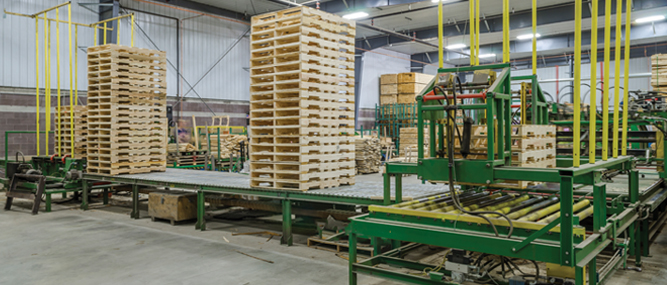Since the advent of the forklift truck in the early half of the 20th century, companies across the world have used pallets to transport goods around warehouses, yards and sites. Day to day operations in manufacturing, shipping and agriculture depend on this staple item to such an extent that over half a billion are produced every single year.
Today, manufacturers produce pallets using a number of materials and to several different specifications. Whether to lease or invest in a set of pallets is also another decision a business must undertake. Other considerations involved in purchasing or leasing pallets include how and where to store them, the machinery used to transport and move them and how to get the best value for money.
This buyer’s guide will help you do just that.
Materials
As seen it pallet yards across the country, wood is the most popular pallet material on the market. Nevertheless, there are a number of other pallet materials available including plastic, metal and paper.
Wood pallets are popular due to their strength, durability and ease of repair. Moreover, they are recyclable and easy to stack and transport. On the other hand, cleaning wooden pallets is difficult and they are prone to degrading, especially if left outside.
Plastic pallets do not succumb to the same weathering as wooden pallets, and are also far easier to clean. Moreover, plastic pallets are typically far lighter than their wooden counterparts and, as a result, their popularity has risen dramatically in the past twenty years.
Metal pallets are popular in shipping and heavy industry, where an extremely strong and durable pallet is required. The downside is, these pallets are heavy and cumbersome; far from ideal on a construction site or farm.
Design
Today pallets come in a variety of specifications, each designed to target a particular use case or environment. Sophisticated software packages allow manufacturers to craft pallets into all manner of shapes and sizes, meaning there is certain to be a design suited for your site.
With that said, most designs fall under two broad categories; block pallets and stringer pallets.
Block pallets are often known as four way pallets due to the fact that their design allows for the entry of a forklift truck on each its sides. The attachment of the top boards to perpendicular stringers, which are then attached to corner blocks leaving gaps on each side for forks. There is no need to cut notches in the side as there is with stringer pallet design.
Stringer pallets, on the other hand, are constructed of parallel stringers attached on either side. As a result, notches often have to be cut to allow the entry of a fork.
Pallets come either double or single sided. The former configuration allows them to be used either way up, although the latter, known as a skid, does not.
The International Organisation for Standardisation (ISO) defines six pallet dimensions, which are commonly used across the globe. An 800mm x 1200mm is the most common size available in Europe although others are available should your task require.
Purchase or Lease
Many companies across a multitude of industries choose to lease pallets rather than invest in their own. Pallet pooling involves leasing a portfolio of pallets for a given length of time from a pallet company and has a number of advantages.
Firstly, leasing pallets removes the need for a large investment and fits the CAPEX model of operation that many firms are striving towards. Moreover, leasing pallets removes the responsibility for maintenance and upkeep of the pallet portfolio. In addition, a company can respond in an agile manner if their demand for pallets should change.
Transport
To transport pallets within or between sites, a company will typically require the use of a forklift truck or a telehandler. The former are more suited to warehouses and factories, where terrain is flat and firm whilst the latter is more suited for uneven terrain such as on a construction site or on a farm.
Forklift or telehandler hire is typically the cheapest way of getting access to either of these machines. Contact your local supplier for more information.
Storage
Warehousing pallets on site can be expensive, although if there is space it is far better to keep pallets inside rather than out. The roof and four walls will protect your pallets from the elements, prolonging their longevity as well as the longevity of whatever you are storing on them.
Careful design of a pallet racking system is important to ensure the safety of your staff in addition to making the most of the space you have. Building up is usually cheaper than building out, although take care not to stack pallets too high.
In some cases, warehousing your pallets offsite with a pallet storage company or sending excess pallets back to the supplier is more efficient and safer than storing them onsite. Again, contact your local suppliers for more information.




